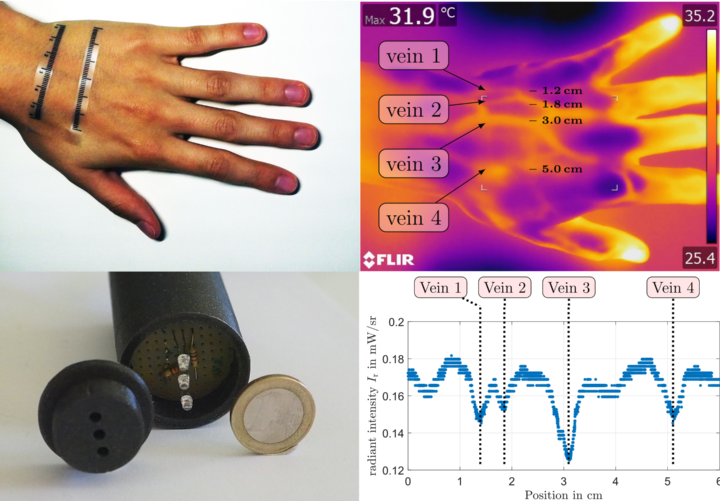Research objective
In the field of optical sensor technology, research is being conducted into approaches that offer low-cost alternatives to cameras, ultrasound or near-infrared imaging for detecting and visualising veins. The simplest and most cost-effective option is to use standard LEDs, which can both emit and measure light. By illuminating the area to be examined, different structures can be detected based on the intensity of the reflected light, which depends on the different degrees of absorption of the tissue types. Research is also being conducted into intensity-based distance measurement and coupling with optical fibres.
Preeclampsia detection
Preeclampsia is a serious pregnancy complication and one of the leading causes of maternal mortality worldwide. It is often associated with water retention (oedema) in the face and upper extremities. This is difficult to quantify using conventional methods. At the IM, water retention in the fingers is detected using absorption spectroscopy. By measuring the specific absorption of light in the near-infrared range, changes in the water content of the tissue that correlate with the development of oedema are detected. Spectra were recorded using silicone finger models with defined, variable water content to determine the amount of water.
Wilson's Disease
Patients suffering from Wilson's disease accumulate copper in their bodies. Copper contamination can manifest itself in the form of Kayser-Fleischer rings (KF rings) – coloured copper-sulphur granules on the edge of the cornea. The reappearance of KF rings in patients taking copper-depletion medication may be an indication of ineffective treatment.
Research at the IMT has led to a handheld sensor system based on measuring the infrared reflection of the cornea, which could serve as a potential method for regular progress monitoring at home. The intensity of the LEDs is harmless to the human eye. As proof of concept, the reflection was measured by placing the sensor on white paper samples with copper tape of different sizes in the centre of the sensitive area. In addition, the reflectivity was determined for various solutions of copper sulphate in saline solution, which were poured into adapter containers fitting onto the sensor head, with the Cu2+ concentrations of the samples taken from the literature.
Optical vein detection
Successful vein puncture is particularly difficult in elderly, dark-skinned, obese or paediatric patients. A new method for vein localisation has been developed at IMT that detects veins using light-emitting diodes (LEDs) and could later be used in robot-assisted vein puncture robots. Since LEDs are used as emitters and detectors, the sensor could be a cost-effective alternative to existing vein localisation systems. The principle is based on a difference in intensity between illuminated tissue and light absorbed by venous blood. The sensor LED is operated in reverse direction to detect these differences in intensity. A series arrangement of sensor and emitter LEDs was chosen for the measurements. Various parameters that influence the vein detection signal were investigated. The positioning of the light sources in the sensor head shows potential for improving the signal level. Correct alignment of the LED array with the vein is crucial for signal detection. Infrared wavelengths are particularly promising for different skin colours. Warming the skin has been shown to improve the signal, while this could not be clearly established when using a tourniquet. The sensor module developed could be used to detect vein patterns. A sensor module could be moved across the skin to scan the area of interest, or several sensor modules could be integrated into a matrix that is placed on the skin to detect the vein pattern.

Selected Publications
- Janzen S, Pott PP, Ödemdetektion durch Absorptionsspektroskopie zur Früherkennung von Präeklampsie, 126. Jahrestagung der Deutschen Gesellschaft für angewandte Optik, 10.-14.6.2025
- Matouq J, Al Saaideh I, Hatahet O, Pott PP, Investigation and Validation of New Heart Rate Measurement Sites for Wearable Technologies, Sensors, 25, 2069, https://doi.org/10.3390/s25072069, 2025
- Janzen S, Wagner J, Pott PP, Early-detection of pre-eclampsia: Concept and design of a portable prototype, 58th Annual Conference of the German Society for Biomedical Engineering, Stuttgart, 18.-20.09.2024
- Mayer J, Narr J, Pott PP, Towards non-invasive Wilson’s disease progression monitoring based on corneal copper levels, 57th DGBMT Annual Conference on Biomedical Engineering (BMT 2023), 26.-28.09.2023, Rhein-Ruhr
- Stewart KW, Liu J, Willmann P, Pott PP, Assessment of a low-cost LED vein detection method - Initial proof of concept, IFAC, 12.-17.7.2020, Berlin




